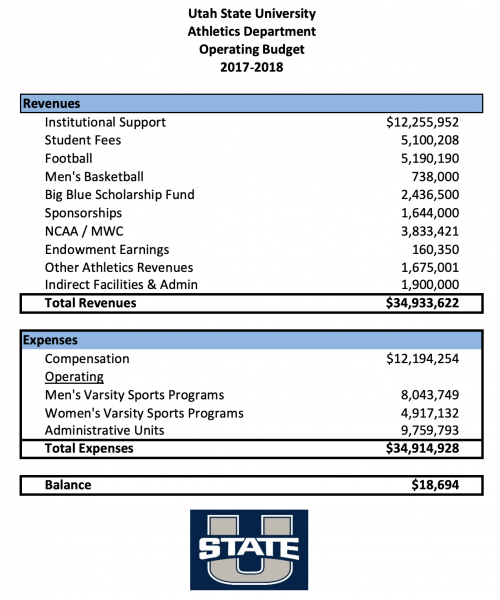On Aug. 10, the Mountain West conference suspended its fall sports season, citing “ongoing challenges with the effective mitigation and management of the COVID-19 virus.”
Not only did this announcement burn a hole in the hearts of Aggie sports fans, but it also burned a hole in the pockets of the Utah State athletic department.
“We think our net loss is going to be about 3.2 million dollars,” said Utah State athletic director John Hartwell. “In all, we got about 8.9 million dollars in revenue that we believe we’re going to lose… we’re going to be able to save in some expenses to the tune of about 5.7 million.”
The majority of the lost revenue comes due to the cancelation of football, where ticket sales and television revenue, among other things, make it the most profitable Utah State sport. But no play also means no travel and game-day expenses for the five varsity fall sports, saving the university some money.
For an athletic department that does not make much more than it spends, 3.2 million dollars is admittedly “a significant amount of lost revenue,” Hartwell said.
For reference, in the 2017-18 fiscal year, the athletic program earned a total of $34,933,622 dollars and had $34,914,928 of expenses for a net gain of just $18,694. So a loss of 3.2 million dollars would put the department in a deficit of roughly, well, 3.2 million dollars.

The 2017-18 numbers do not exactly reciprocate what the department’s operating budget would have been in a ‘normal’ 20-21 fiscal year, as there has been an increase in donors, ticket sales, and tv revenue in recent years, but it gives us a decent idea.
According to a report published by ESPN in May, Group of 5 schools — of which Utah State is a part of — could be hit the hardest without the resumption of football. Among the 56 public schools in the Group of 5, 62.5% get their largest share of funding from government and/or university support, 34% from student fees and 3.6% from donor contributions. Utah State in 2017-18 received the largest share of its athletics revenue from institutional support, $12,255,952 of $34,933,622 total.
So how will the athletic department supplement this loss of revenue?
According to Hartwell, the first step of action is to try to gain more financial support from alumni.
“We launched our Aggie strong campaign which is a new fundraising effort with an increased focus on basically on helping us bridge that gap quite frankly,” he said.
The department is looking to get 2,020 donors involved in this new fundraising program before the end of the year. To this point, 500 people have signed up, just two weeks after the campaign launched, which Hartwell has deemed a success.
Another potential way to make up some of the lost revenue is by playing a spring football season.
“If we could do that it would help us to be able to recoup some of our television revenue which is a significant amount and then some ticket revenue, maybe not the full amount, depending on what we would be able to seat in the stadium,” Hartwell said.
Utah State football head coach Gary Andersen did not seem as optimistic that a spring season could be a possibility.
In a recent conference call with the media, Andersen was reported as saying that a spring season was “not feasible” and potentially detrimental to the players’ health.
“I’m always going to be in it for kids. I’m never going to stop saying that,” Andersen said. “That is not a possibility for our young men to play 20-plus football games in a year if I have anything to do with this decision.”
If the spring season did come to fruition, it would likely be just seven or eight games. Anything longer, and it would not give the student-athletes a chance to recover, and then recondition for a season that following fall, according to Hartwell.
Despite these efforts to get more donations and to have spring football season, the concern is that it may not be enough, and the program will still be stuck with a large deficit. That could put the university in a situation where they would potentially have to cut some sports or furlough employees, similar to what has happened at Boise State, Akron, and several other schools.
Hartwell is determined to prevent this from happening.
“Our overarching value since this whole thing started back in early March was the three main goals that we’re trying to protect. We’re trying to make sure that we protect sports, that we protect scholarships, and that we protect jobs.”
Hartwell credits his department’s “lean and mean” approach of doing things for keeping the program in a position where they don’t have to resort to eliminating the sports, scholarships, or jobs.
When the spring season was canceled back in March, the athletic department decided that “the only expenditures that we’re going to have are necessary expeditors.” Hartwell said. “Our coaches and staff did a great job in that and actually for the fiscal year that ended on June 30, we actually ended in a positive, which you know was quite a feat, knowing that we lost a million-plus dollars in NCAA tournament revenue.”
Hartwell said that that frugalness will continue into this new fiscal year.
“We continue to maintain that focus,” he said. “Again, we got an uphill climb facing potential revenue shortfall. But we’re working at it.”
@jacobnielson12
— jacobnielson12@yahoo.com
"correct" - Google News
August 31, 2020 at 10:00PM
https://ift.tt/2YMrAG3
USU Athletics attempting to correct financial loses due to COVID-19 - Utahstatesman
"correct" - Google News
https://ift.tt/3d10rUK
https://ift.tt/35qAk7d
Bagikan Berita Ini














0 Response to "USU Athletics attempting to correct financial loses due to COVID-19 - Utahstatesman"
Post a Comment